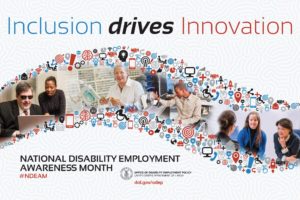It’s well-established that hiring employees with disabilities makes good business sense. And when 1 in 5 Americans has a disability, according to the U.S. Census Bureau, a good proportion of your workforce is likely impacted.
The Americans with Disabilities Act (ADA) protects people with disabilities from discrimination. Plus, it requires workplace accessibility and reasonable accommodations for employees with disabilities who need them. But have you taken any time to think about how friendly and welcoming your workplace is to people with disabilities, above and beyond the requirements of the ADA? We have some ideas for how you can ensure that employees with disabilities have a positive experience with your company.
1. Actively recruit Employees with disabilities.
You hopefully already have an Equal Employment Opportunity (EEO) policy that encourages applicants with disabilities to apply. Include a similar line in your job ads to start attracting candidates with disabilities. In addition, attend job fairs geared toward people with disabilities, such as those hosted by Incight in Portland. Or partner with a nonprofit organization or an agency (like yours truly) that specializes in employing people with disabilities.
2. Educate your workforce.
Part of creating a welcoming environment is being respectful when speaking about disabilities and not using dated, offensive terms. Using person-first language is a good first step – such as referring to a person with a disability rather than a disabled person. A disability training by a qualified professional can help explain the importance of language. At DePaul Industries, we have an on-staff rehabilitation counselor who conducts these trainings with all new employees. A nonprofit organization or HR consulting firm in your area may offer a training like this. And observations like National Disability Employment Awareness Month are great times to hold educational events or discussions and recognize the contributions of your employees with disabilities.
3. Recognize that not all disabilities are visible.
You or some of your employees may assume that you can always see a person’s disability, but that’s absolutely not the case. Many people have invisible disabilities (also referred to as hidden disabilities). This includes conditions like a hearing or vision impairment, epilepsy, chronic pain, Crohn’s disease, major depression, or being in recovery from alcohol addiction, among many others. While much imagery regarding disabilities includes individuals in wheelchairs or using canes, remember that you can’t make assumptions about whether someone has a disability based on their appearance.





